When leading American wine writer, author and philosophical commentator, Matt Kramer, visited Singapore last year the first thing he asked me was to bring him up to speed on the dynamics of the market and given his time constraints, he would like to meet the one person who is influencing the market here most, “The gatekeeper to the evolution of wines styles and trends, the evangelist of the wine culture, the inspirer of thirst.”

Henry Hariyono and Matt Kramer outside the front of Artisan Cellars
Kramer is himself a forecaster of style and global missionary on wine; inquisitive by nature on what is shaping the markets and wine drinking trends everywhere.
Without hesitation I said, that will be Henry Hariyono – the man is a wine oracle. Indeed, wine is a religion to Hariyono; he’s a man who now devotes life to contemplation of wine along the lines of a Burgundian Monk with a bit of Friar Tuck in his preaching.
You won’t get any animated sermons out of Hariyono; he’s pretty quiet natured and could easily pass as a wine geek – but he’s not geek – just totally obsessed with good wine or more specifically ‘Artisan’ wines and is a partner in Singapore-Malaysia-Indonesia wine merchant, Artisan Cellars (www.artisan-cellars.com)
When I first met Hariyono, I instantly sensed here is a person with real wine Mojo – the sort of deep understanding of the intricacies of wine and yet not caught up in the elitism or snobbery that unfortunately pervades Asian wine-drinking sentiment and that proneness to being slaves to brands.
In a way, Hariyono filled a void left by the departure of Andy Tan, the Singapore- sommelier-allomorph-wine merchant who moved to Shanghai to run China’s largest importer of wines private client fine wine division. Tan’s approach though was a little more zealous, more televangelist and the man can talk underwater.
Hariyono is certainly not lacking in passion and spreads the vinous word in a predicated manner with a compulsion towards small, individual vignerons that invariably practice organic or biodynamic viticulture and adhere to minimalist and natural winemaking methods.
However, what is I find most refreshing in his approach and rare in this part of the world, Hariyono does not discriminate between the ‘New’ and ‘Old’ worlds of wine or more pertinently does not partake in French bias and is resolute and true to his philosophies and the imperatives that a wine must have ‘a sense of place’ and real character and made by genuine people regardless of where it comes from. They are simply as passionate about California and New Zealand as they are Burgundy and Champagne.
Make no mistake though, Hariyono is engrossed in Burgundy, although it perhaps comes second to his predilection for Grower Champagnes, nevertheless I believe it speaks volumes that he and Artisan Cellars are devoting their time and resource to exploring New Zealand and specifically the topic of pinot noir with a relevance to price/quality rapport but does New Zealand have what it takes to be a real player in the pinot stakes, or chardonnay for that matter.
Hariyono’s wine manifesto comes largely by electronic bulletins and he writes very well; actually his talent for wine prose exceeds most wine writers in this region, hence I asked him if he would mind my reproducing a most informative piece he wrote recently on New Zealand pinot noir and chardonnay.
Admittedly, and unashamedly, I am a champion of New Zealand wines however I am willing to concede my patriotism sometimes compromises my Antipodean rhetoric, thus I thought it would be beneficial to all in gazetting Hariyono’s account of his travels through some of New Zealand’s the South Island wine regions.
It is a refreshing and profound assessment that I hope will dispel some of the misconceptions that I hear from less-informed commentators; insinuations that New Zealand pinot noirs have a ‘sameness’ and prevarications from the ‘Old’ quarter of inferiority pedigree and quality.
More importantly, it emphasises the importance of pinot noir and other cool-climate varieties in the Asia market and the synergies it has with a breadth of cuisines. Japan and Singapore are arguably the most developed wine markets in this sense, however I would suggest there is much potential for new world producers beyond this, at the same time reinforcing that Asia is not just Hong Kong and China.
Meanwhile, I would highly recommend you follow Artisan Cellars, no matter where you are on the planet, at (www.artisan-cellars.com)
Facebook http://www.facebook.com/profile.php?id=100002574205963&ref=tsand
Twitter handle (@artisan_cellars)
A NEW HOPE, WAY DOWN SOUTH
Why New Zealand Pinots are not just fashion
— Henry Hariyono
It seems that the high-end wine market is going ballistic with Burgundy. Price corrections are taking place for blue-chip Bordeaux, an inevitable situation given the rapid, relentless escalation of its prices these past few years, a phenomenon fuelled single-handedly by China’s seemingly insatiable appetite for the finest “branded” French wines.
As blue chip Bordeaux is forced into introspection, its captive audience and their monies naturally lean toward Burgundy as reported in recent auction in Hong Kong (see this link). This spells mixed news for the avid Burgundy lovers. Collectors who own ample fine burgundies in their cellar may be sitting on vinous treasure worth a lot more than originally anticipated while the less well-endowed others have to work harder to either procure from other producers or appellations, or be prepared to increase their budget in order to compete with the new converts of these limited wines.
Sometimes I can’t help but feel the Old World folks have it easy. We speak so matter-of-factly of Burgundy (or the French appellations more generally) as reference standard where vitis vinifera thrives to make wines of supreme quality. And we will pay for it. Conversely we conveniently think that no matter how hard the New World works on making its mark it will find little success, even at the premium end. This sounds like wine snobbery indeed, and I for one have to admit that I used to think this way at some earlier points of my wine-loving life.
Gratefully and serendipitously I met a number of passionate, erudite and influential people from the New World wine countries along the way. They shared openly about their passion and experiences and as I taste more of the excellent and highly original examples from these newer regions, I was set free from my bias and became truly curious about what these wines have to say.
Last November I decided it was time to visit parts of New Zealand’s South Island, if nothing but to address a nagging doubt: does this country have what it takes to produce truly great Pinot Noirs? Steeped as I am in my Old World tastes, I noted that I have tasted far more unique excellent New Zealand Pinots than any other countries, and for this reason it thought it sensible to visit the wine countries here. Work aside; there is an urgent personal need to find a more conclusive stance beyond what my instincts will ever inform me.
The beauty of New Zealand is so breathtaking it was almost a fatal distraction to our expedition. I was quite unprepared for the beauty that awaited me. No wonder filmmakers flock here to shoot their movies — they are as spectacular as what you see on the big screen. Every view, whichever way I looked, was postcard-perfect picture. To add to our fascination, the people are genuinely nice. The surreality of it all is as intriguing as it is impossible to forget.
We soon found out that the country’s beauty is not just skin deep. Reminding myself that our quest for the most compelling expressions of Pinot Noir outside of Burgundy has taken us this far down south, we knew we had to earnestly soak in as much as we could in order to make good of our original intention. Thankfully right from the first address we visited we were beginning to get some rather clear answers.
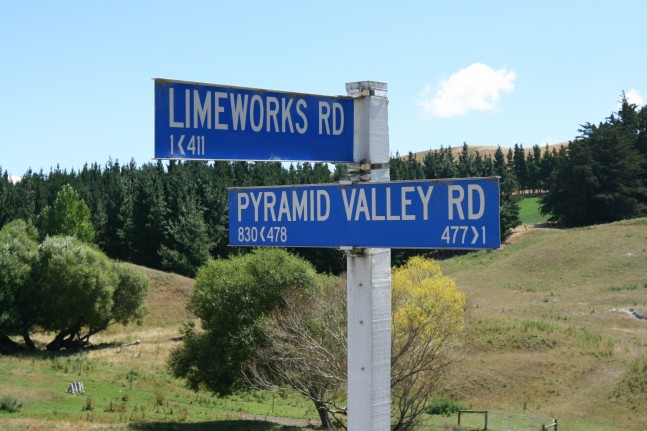
Pyramid Valley - Limestone Central
NORTH CANTERBURY
A cheery Claudia Weersing greeted us as we arrived the iconoclastic PYRAMID VALLEY estate, her palms and boots stained with dirt after a full morning out in the fields. The sun was glorious, imbuing the picturesque farm-cum-vineyard with remarkable luminosity. I was instantly reminded of the fact that grapes love light. Here, you get light aplenty it seems.
Mike Weersing, after plucking some biodynamically grown produce from his garden whipped us a delicious lunch in no time. The story he shared as we chatted recounted a madcap journey of a truly dedicated and fearless disciple of the vine. Having graduated from wine schools in Dijon and Beaune, Mike diligently worked at every corner of the earth, growing and making wines. His résumé is an endless list of wine world’s who’s-who which includes famous estates in Burgundy, Alsace, Loire, Rhone Valley, Languedoc-Roussillon, Mosel, Australia, New Zealand and Oregon.
As he travelled and worked, he continuously searched for the perfect place to grow his favourite grapes and after scouring for over three years in New Zealand he found true limestone soil in Waikari, North Canterbury. Instructed by his diverse experience working in some of the most revered wine producing regions, Mike has inculcated an innate instinct of what kind of soil and microclimate to grow his favourite Pinot Noir and Chardonnay grapes. Mike and Claudia promptly purchased that piece of land and it became Pyramid Valley Vineyards’ home in 2000.
Mike has always known there is only one way to go in the vineyard: biodynamic. The land was unblemished and remains pure as a result of his biodynamic farming at inception. Roots grow rapidly into the rocky limestone soil seeking mineral nourishment. The vineyards have a certain tranquillity about them on the surface. The soils are alive and the vines are peacefully set in a thriving ecosystem hosting within it insects, flowers and livestock’s.
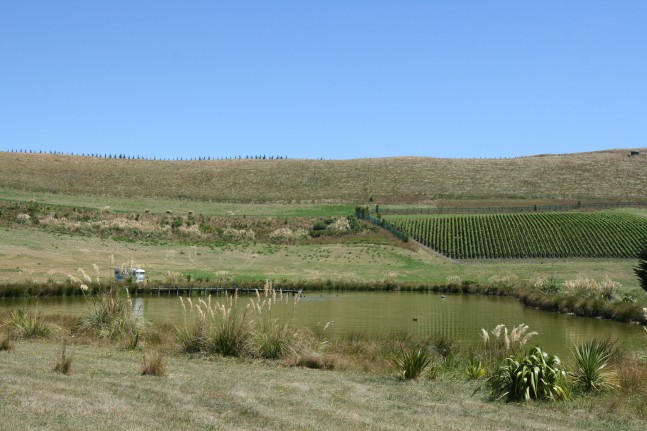
Pyramid Valley vineyard vista over dam
Cellar work is simple yet cutting edge in certain ways. Tanks, barrels and clay amphorae dot his tiny cellars. The wines ferment naturally catalyzed by vineyard yeasts, unaided and unprompted by human hands nor external agents. They rest and grow up at their own pace. Mike never hurries their upbringing in neutral vessels as he lets the wines strengthen and express their nature. Bottling is done with minimal sulphur added.
Pyramid Valley’s Waikari-grown Pinots have only been made in five vintages but right from its early releases; these biodynamically farmed, phylloxera-free, poor soil, ultra-high density vineyards have yielded highly distinctive Pinot Noirs that gloriously display palpable salinity and minerality. The Pinots are vinified with their stems. Its perfume and unfiltered cloudiness may call to mind older examples from Domaine Dujac or Prieuré Roch, yet the palate impression remains supple and plush with mouthwatering drinkability I wish more wines from anywhere will possess.
The Chardonnays are even more accomplished in my opinion, for its pliancy and transparency. No blowsiness can be found here although the wines are amply fruited. Indeed what takes my breath away is the sheer rocky minerality that truly defines the white wine’s original substance. To approximate its restrained frame, think along the line of a hybrid between Meursault and Puligny.
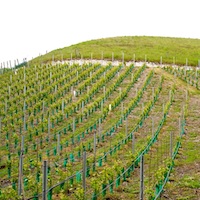
Bell Hill vineyard
The story of Pyramid Valley’s equally famous neighbour BELL HILL is as contrasting as it is similar. Mike and Claudia are good friends with Marcel Giesen and Sherwyn Veldhuizen, the couple behind the micro Bell Hill estate. After all, they are the only two neighbouring estates growing wines in Waikari.
Similar to Mike’s quest, the couple’s dedicated search followed by a thorough soil research confirmed that the limestone-laden composition is what it is: a natural and encouraging environment to grow soil-driven Pinot Noirs and Chardonnays. The plots at Bell Hill are phylloxera-free too. They do not admit visitors readily here for a variety of reasons, but quite importantly because they would not risk probable contamination that could bring unwelcome ailment to their vineyards. (When you have a virgin land, untainted and as perfect as this, not to mention that you live by its minuscule yields, you won’t take chances either.)
Externally Bell Hill could not appear more different than her neighbour. While the Pyramid Valley property looks somewhat quaint and cosy, Bell Hill’s approach is visibly more contemporary, design-oriented, and with more noticeable use of technology in and around the property. The couple invest in tools needed to inform them of weather changes around the estate so that they can respond promptly to oft-changing marginal conditions about its vineyards.
The vineyards are closely placed next to each other, wrapping snugly around small hills and peaks. The couple has swung fully into biodynamic after starting out with organic viticulture. Vines are extremely densely planted at 11,000 vines per hectare. (10,000 vines/ha is quite normal in Burgundy, Pyramid Valley does a mindboggling 12,000, while most of other regions in NZ does around 4,000 — just to give a perspective of how committed these folks are.)
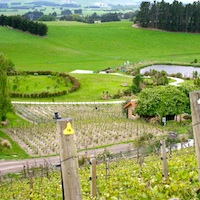
Bell Hill vineyard view from the top
As we descended into their cellar that we saw the full extent of their madness. In spite of their tiny average production of only around 4,500-bottles annually, Marcel and Sherwyn have parcelated every block and vinify the wines in separate barrels of varying toast levels depending on vine age and the character of its fruits. Of course the barrels are from Burgundy (where else!) made by a cooper whom they have a close personal relationship with. The couple has tight connections with their Burgundy colleagues — they visit Burgundy regularly for both professional and personal interests.
Pinot Noir rules here, plus a tiny amount of Chardonnay, both of which are jaw-droppingly good. It is not by luck that the estate’s Pinot Noir arrived at the apex of New Zealand Pinot Noir classification within a short time of its existence which is no mean feat at all.
Marcel prepared for us a delicious lunch using lovely organic local produce. He’s a passionate cook with impeccably good taste, if I may say so myself. With the meal, Sherwyn staged a vertical consisting of 3 vintages of Bell Hill Pinot Noir and Chardonnay. It is touching to see how tiny the production of each of these vintages as seen printed on their labels, and the fact they pulled a bottle out each just to let us taste over lunch underscore their generosity and sincerity.
The Pinot calls to mind Chambolle-Musigny’s indisputably elegant upper crus while the Chardonnay marries the understated richness of Chassagne and precision of Puligny, even the meaty stoniness of Chablis in certain vintages. Ethereal in its classiness and because they are derived from similar limestone soil base, each wine’s finish elongates with startling savoury mineral tones as well. Yes, umami maximus. The theme continues on it seems, at least while we are drinking Waikari’s finest produce.
CENTRAL OTAGO
We travelled south-westward into the hotbed of New Zealand Pinot Noir: Central Otago. The famous Central Otago fruits regularly feature luscious, evenly ripened, juicy, clean flavours which are varietally unmistakable as Pinot Noir for which they are justifiably renowned for. The weather here is auspicious by and large every year, producing relatively deeply collared Pinot Noirs blessed with enchanting aromatics and sweet fruits (which at times seem too candied perhaps) which have won it many fans.
The region itself is quite spread out and hence it is logical to expect that the different soil structures and microclimates will generate a bevy of Pinot Noirs that should vary noticeably in character. Ironically, my past tastings found too many of them too similar with each other rather than what its exact origins would suggest. Quality is never wanting generally as the people here know how to make a good Pinot Noir indeed. But if one is looking for true complexity imbued by original soil tones, finding clear and unique examples may prove to be not that simple a task, my feeling says.
My friend Stephen who is one of the most respected on-trade consultants in New Zealand gave me a few names to check out before we set off to Central Otago. I trust Stephen, because he has such a fine and well-informed palate not to mention he is such a highly connected veteran in the industry (in spite of his youth). We regularly exchange notes and taste together whenever we get to meet. I take everything Stephen says particularly seriously especially because I do not do business with him. Ours is a meeting of shared passion and wine philosophy, nothing more, nothing less. His advice is particularly handy as we resumed our trip.
Before we left North Canterbury, Pyramid Valley’s Mike Weersing gave me a particular name to check out in Central Otago which merrily coincided with someone Stephen mentioned. My wine radar was on a full alert by now and within two hours of reaching Queenstown; I was in Gibbston’s MOUNT EDWARD winery.
Yoshiaki Sato, or Yoshi as he likes to be called, beckoned me to step in the secluded winery as I arrived underneath a light drizzle. Yoshi makes wine in Mount Edward winery, assisting Duncan Forsyth, the general manager and chief winemaker who happened to be away on business when I visited. I was impressed by the Mount Edward line-up, no less because the winery made a lovely rosé and crisp Rieslings (which I feel Central Otago is particularly gifted for, having tasted exemplary wines from various addresses) amidst its excellent Pinot Noirs. After close to an hour of tasting, I blurted out what I had been itching to ask since I arrived, “I heard that you make your own wines. Do you think I can taste them?”
Yoshi was as surprised as he was delighted by my request. By the side, he makes wines under his own SATO label from organic plots at Mount Pisa, some 40-odd kilometres away from Gibbston. Yoshi considers Mike Weersing as an inspiration to his method of working. By this he meant natural winemaking. He has been realising his wine growing passion having worked in Domaine Bizot in Vosne-Romanée and Pierre Frick in Alsace, amongst other places. Prior to his present appointment in Mount Edward and starting his eponymous label, Yoshi worked with Blair Walters in Felton Road.
Sato wines are particularly original in that it was decidedly individualistic. In a region where good and clean Pinot Noirs are a norm, the delicate earthy pungency of Yoshi’s Central Otago wines is particularly refreshing. Fermented whole-bunch by way of indigenous yeasts, Sato Pinot Noirs are structured yet express the ampleness of dark fruit tones of the region. It is distinctively savoury, almost saline in fact, in its sneaky finish. This is something you can’t say for an overwhelming majority of Central Otago Pinot Noirs, not even from some of most celebrated addresses.
Production of this underground winery is minuscule of course, somewhere around 3,000-odd bottles each year. Like Pyramid Valley’s, Sato’s wines are bottled with extremely minimal levels of sulphur. Here is an exacting artisanal natural wine par excellence. The soil character shines through, and that to me is the most important thing for wine whatever the varietal is and wherever the wine may come from.
Pinot Noir is particularly articulate in this regard and without it, a glass of Pinot, no matter how well made is really quite pointless. Yoshi does not sell his wines domestically, exporting them wholly to Japan and Australia. They are sold out before each vintage release is officially completed; underscoring how fanatical his customers are and his tiny production does not help. I can’t wait to introduce them here in Singapore in a few months time.
A couple of kilometres east found us at the door of AURUM at Cromwell. Lovely, very kind people run this place. We were welcome by the kindly Joan Lawrence and her daughter-in-law Lucie Lawrence. Literally a Burgundian in Central Otago, Lucie is now in charge of the estate’s winemaking. She is a third-generation winemaker in her family in Burgundy, having been fully equipped and trained in Dijon University. Life seemed settled in Burgundy for her but after meeting Brook Lawrence at Domaine d’Arlot while working together, they married and she moved to join the Lawrence family who owns and runs the Aurum estate.
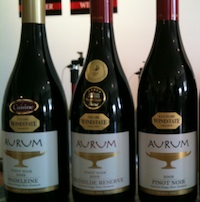
Aurum
At Aurum, both viticulture and cellar practices are increasingly becoming more natural now with Lucie and Brook at the helm. The estate is evolving into full-blown organic viticulture after having practiced sustainable farming for some time. After tasting the various cuvées of the Pinot Noir the result of this approach is quite apparent. Not merely ripe-fruit driven, the wines have a certain touch of restrained elegance about it with a lovely clarity and coolness in the finish particularly welcome in a full-bodied year such as 2009. Quite importantly, they are pure and delicious to drink.
Everything at Aurum is pointing in the right direction to make wines of terroir and distinction. With the special cuvées (picked purely based on barrel selection and lovingly named after Lucie’s daughters), these reserve Pinots seem more intense and, once again, inflected with an earthy savour evident in the longer finish. There is a very definite vibe that this estate is on to great things, their sensitive approach propped along by a strong family spirit and shared Burgundian sensibilities in the vineyard as well as in the cellar.
The couple is making sure to do less so nature’s imprint show more clearly in their wines. I for one am confident that if they are already this good now, they would be even greater in no time indeed.
We headed north towards Wanaka. The town of Wanaka is small but colourful and lively, a real charmer. Our destination was a place that seasoned Pinot aficionados in New Zealand would be whispering to each other about: RIPPON. Nick Mills, the owner, grower and winemaker is a bundle of energy bursting from the inside that belie his gentle demeanour and I felt it the moment we shook hands.

Nick Mills - Rippon
There is some serious biodynamic agenda brewing all across the estate and it was all Nick’s doing. The estate is blessed with vine plantings that started as early as the earlier part of 1980s back when Nick’s father decided to grow vines, a decision he made based on both intuition as well as years of soil and climate studies foretelling that their lakeside land had a profound potential to making fine wines of distinction.
This same acute intuition for viticulture has passed down easily to Nick. Listening to Nick and walking around his vineyard took me on a giddying ride into biodynamic alternate universe. Nick spoke convincingly about the flow of energy across his entire estate, how it cascades down the different levels of the hill and cycles back up again into the winery. He made us hold and smell his compost soil mix (warm, alive and fragrant) to prove how much of a good life there was in his soil. He picked up a slab of schist. Finely layered as a millefeuille and brittle, it snapped easily when a small force is applied.
Nick explained that because of this the vine roots can easily traverse downwards to find its natural nourishments. The vines, quite old by New Zealand’s, or particularly Central Otago’s standard, cultivated biodynamically since Nick’s arrival in 2002, having just returned from Burgundy, are indeed special. There was an inexplicable sense of spiritual calm as I walked around the vineyards. It seemed everything and everyone is living happily together here.
Lake Wanaka lies in waiting just ahead of the vineyard, forming a quiet gigantic stage which overcast the growing vines, ever ready to protect them from the elements and even to nourish them. It is one of the most spectacular sights I have ever seen. And it seems impossible if the wines were not as beautiful. But what are we to expect exactly?
Rippon’s cellar is a small, somewhat erratic cornucopia of steel vats, pipes and oak barrels. Whilst I was beginning to get used to tasting soil-inflected Pinot Noir, I still could not overcome the shadow of my past experiences which recall candied fruits which characterise most Central Otago Pinot Noirs. Thankfully that fear is totally unfounded at this address.
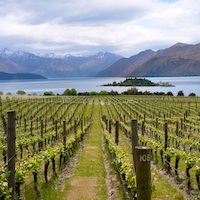
Rippon Vineyard
I texted my buddy immediately after the visit, announcing to him this is one amazing estate. Why? He asked. Because there is salinity in every wine. And spiciness. And seamlessness. And deliciousness. The Pinots are naturally ripe, complete, and profound in the single-block bottlings, but even the “basic” Mature Vines Pinot Noir already exhibits perplexing evolving complexity. Elegance and finesse prevail here. This is as authentic and excellent an expression of Central Otago as I can hope to encounter.
In short, truly fascinating stuff. And for all the unstoppable train of elaboration Nick could not help but spill out regarding his vineyards, he became very quiet in the cellar. It is as though he had let go of everything at this stage and knew the wine had made itself.
(Our Central Otago visits to FELTON ROAD, LINDIS RIVER and VALLI point to more or less the same direction. Perhaps their tales will be better served if told in future stories.)
When it comes to Pinot Noir, a comparison with Burgundy is inevitable. In this holy ground, the grapes seem to recede into the background as terroir shines brighter than the varietal. It is a marvellous accident, a sheer genius as a matter of fact, which only a union between Nature’s incomprehensible bounty and Man’s willingness to work with it respectfully can produce.
The spirit of letting terroir take precedence over varietal, however, remains as the ultimate goal of anyone making fine wines of distinction, never mind the origin. The challenge that a New World wine faces has always been to try articulate its sense of place as clearly and excellently, not merely content with ensuring correct varietal expression. There is nothing wrong about being varietally accurate, of course, but in the realm of truly fine wine capable of arousing emotion and stimulating the intellect, a wine must possess a depth of soul that simple technical correctness will be inadequate to describe.
It is paramount for a fine wine to be distinguishable and distinguished. Only a gifted terroir and equally gifted wine grower can produce that. This trip has revealed that New Zealand is blessed with the right talents in terms of terroir and visionary growers. No, the wines are not Burgundy imitators, let alone Burgundy replacements. These growers, as profoundly inspired by Burgundy as they can be, are under no illusion that they can recreate Burgundy here. Instead they work lovingly with the sites they have mindfully chosen to find its unique soul which they seek to faithfully express in the wines. The results have not only been encouraging, they are often downright delightful.
The visit has planted a firm conviction in me that genuinely great Pinot Noirs can arise from certain locations in the South Island. Yes, this is me, a self-confessed, unrepentant Burgundy-head talking. And it is not for Pinot Noir alone, by all means. Many startlingly profound examples of Chardonnay from North Canterbury and minerally Riesling from Central Otago I have encountered in this trip all go to no insignificant extents to support my happy conclusion.
The backbone of New Zealand’s rise in the Pinot kingdom of the world is the strong presence of this handful yet growing number of smart, viticulturally sensitive artisans, full of ideals shaped by their Old World experiences, taking full responsibilities to grow the right grapes in spots and wrinkles of the country where soil and microclimates happily agree.
Committed to working naturally in the vineyard and in the cellar, they have successfully crafted beguiling wines informed by an unmistakable voice of its soils. What’s more exciting is that they are still on an up-curve, meaning that with more time, their vines and their understanding of their terroir will deepen, and so their wines will become even greater.
With land prices remaining relatively reasonable, these growers are free to perform their work faithfully and still charge fair prices for their craft. Once consumers understand who the most conscientious growers and estates are, options abound for them to pick their favourite authentic Kiwi Pinots for a variety of occasions with confidence. Be it an affordable, refreshingly fruited personality-filled wine or a more cellar worthy cuvée from special plots with barely a more premium price-tag, New Zealand has them all.
For these reasons and then some, we came home feeling sanguine that these Pinots are the New Hope we had once thought they were. As a side note, many of the most experienced Burgundy collectors I know have been buying New Zealand Pinots for their cellar, so I know this vibe is not my own dreaming.
I am sipping the 2009 Rippon Mature Vines Pinot Noir opened the day before and can’t help smiling as I notice how harmonious it is. It is more delicious than when it was first opened, turning brighter, spicier and more delightfully alive the more I engage it. The New Hope I have come to conclude as this wine characterises so well is as real as it gets even in this “generic” bottling. And all of us should be all the better because of it.
|
|
Tweet |

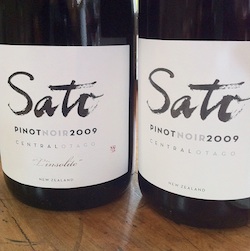





5 Comments to Wine Evangelist | Comments Feed
Thankyou Curtis for a splendid introduction to the erudite and thoughtful writings of Henry Haryono. I shall be sure to follow Henry and Artisan Cellars and increase my understanding of the artisan wines he so admires!
Otago pinots are big, and there’s no gentitg around that; even picking as early as possible (without being underripe) doesn’t really help. But most producers are doing what they can do avoid overripeness and excess size. There’s only so much they can do, but in the greater context of Otago pinot, this one’s dark but actually on the less aggressive side.It would be interesting if you could get a bottle of the Wild Earth bottling (e.g. no “Blind Trail”) for a little more money. (Note .) Then compare; I think you’ll find this one lightens by comparison.Or maybe you’ll find them both shiraz-like. 😉
Valuable information. Fortunate me I found your site unintentionally,
and I am surprised why this accident did not took place in advance!
I bookmarked it.
A good accident! Welcome to the Wandering Palate and we hope you return often… Cheers Curtis
Attractive section of content. I simply stumbled upon your website and in accession capital to assert that I acquire in fact loved account your weblog
posts. Anyway I’ll be subscribing on your feeds or even I fulfillment you get admission to consistently rapidly.
The comments are closed.